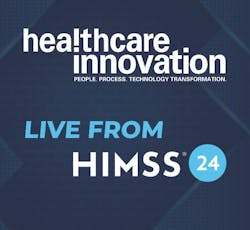At HIMSS24, a Frank Discussion of the Challenges of Achieving Automation at Scale
What is the path to artificial intelligence-leveraged automation of processes in patient care actually like? Well, as with everything related to AI, it’s turning out to be a complicated, winding one. That was the consensus of a panel of discussants in a session on Wednesday, March 13, at HIMSS24, being held at the Orange County Convention Center in Orlando.
The session, entitled “Digital Transformation from Screening, Diagnosis to Personalized Care,” was moderated by Moritz Hartmann, a senior executive at Roche. He was joined by panelists David McClintock, M.D., chair of the Division of Computational Pathology and Artificial Intelligence at Mayo Clinic (Rochester, Minn.); David Vawdrey, Ph.D., chief data and informatics officer at the Geisinger Health System (Danville, Pa.); and Jina Forys, operational director at MHealth Fairview.
Hartmann began by referencing a few recent studies based on surveys. In a survey whose results were published in the “2023 Report on Innovation in Data-Driven Healthcare,” the results of which were published in the Harvard Business Review in 2023, found that 88 percent of survey respondents agreed that managing operational data across care settings is very important, but only 22 percent felt their organization had been successful at it. He also cited another study that found that the low level of interoperability is costing the U.S. healthcare system $30 billion a year.
Early on, the panelists agreed that AI offered tremendous potential for the leaders of patient care organizations to improve digital health and healthcare delivery more broadly, but that it will take some time for strategies to begin to mature.
Hartmann asked how digital solutions can impact care. “It comes down to what the clinical use case is,” McClintock responded. “We’re really looking at bringing in multiple different areas, and bringing in data to develop a model, in ways that won’t add additional steps to process, while also making sure you don’t cause harm to patients. You have to bring all those different aspects together. I had a friend of mine who’s a pathologist, who said, hey, I have an algorithm I’ve built and published a couple of papers on it, can you help me deploy it? It seemed like an innocent request. But I found out he used a third-party solution, there was cybersecurity risk, the workflow was all manual to execute on the algorithms; and I asked him, how do you think the clinicians will react? And he said, well, I’ll add an addendum to the end of my paper. So when you think about building out solutions, you have to begin to think about how to build a roadmap. What are the resources needed? And will clinicians want to use the algorithm clinically? And who will support it? All those things, including the regulatory aspect, need to be put together.”
“I manage the laboratory,” Forys emphasized. “And how can we use the data to create more actionable data for the clinicians? A lot of lab results go out that don’t necessarily mean anything. There are a lot of opportunities to do things together. And, to Dr. McClintock’s point, why? What’s worth investing in and worth fighting for? And what needs to be set aside so we can focus on the top priorities? That’s the issue now.”
A sense of perspective around all this is worth keeping in mind, Vawdrey said. “Twenty years ago,” he noted, “I was a Ph.D. student, and the president was talking in his State of the Union address about how every American should have an electronic medical record. And it was before the first iPhone was manufactured. We’ve come a long way in the past 20 years,” he emphasized.
One of the challenges now, the panelists agreed, is around the temptation to take “easy” shortcuts and simply attempt to implement algorithms from external sources; that would be a mistake. “If I take an algorithm from a different organization, could I actually be creating harm?” McClintock asked. “So how do we go about doing this? We have to look at your own journey and ask, what have we been doing well? What can we do well? In our case, we’re putting all our data into the cloud. But not everybody knows how to use it or what tools are available. And understanding that you might have the same data in five or six places—what does that mean? You have to look at your data and information systems systemically. Everybody wants to jump in right away and do large language models and generative AI. But not everyone is capable of doing it right now.”
“What has changed for you in terms of selecting industry partners?” Hartmann asked the panelists. “We’ve been actively reducing our list of vendor partners; we’ve tried to focus on deeper relationships, ones of quality; this is expensive,” Vaudry underscored. “And we’ve found more success form a cost-effectiveness and efficiency post of view, and provided better service by simplifying our vendor stack.”
“In our organization, it’s not unlike what you’re describing,” Forys replied. “There’s definitely a move towards a smaller number of partnerships, and collaboration. But collaboration is a buzzword. What does it mean? I think the kind of collaboration I’m looking for as a customer, is that I want to help a vendor to be successful, and I want them to be supporting our work. And it’s great to have visionaries, and it’s a great thing. But to have vendor partners who can help us realize the vision, without having all the risk being on the provider organization.”
Indeed, McClintock noted, “Vendor partnerships are changing a lot. And you need to be honest with what you want.”
“People want access to care, whether it’s emergency care or being able to get a primary care visit within a day or two, or a specialist within a reasonable period of time,” Vawdrey said. “So, access is number one. And all of us want high-quality care for our family members and loved ones. And the third thing is experience. I wanted to be treated well as a consumer of healthcare and have a positive experience. Quality on the top divided by cost on the bottom: it’s a simple equation. We have to focus on affordability.”
How to deal with legacy systems and integrate them into new solutions? “I think this idea of rushing to the next technology—we need to step back and think,” McClintock said. “In general, I would pose a word of caution. Do you really need that new system? It will require a lot of work to bring it in. So you need to go through a whole process around that.”
Hartmann turned to Forys and said, “When labs started to evolve forward into automation—what is the role of employees in this whole transformation? Do we need to take them along?”
“For sure take them along; don’t leave them behind!” Forys replied. “Think about the laboratory of the 1960s: pipettes, everything, everything was manual. Now, everything is automated. So the way you train a laboratory professional is different; you’re not training them for accurate pipette-ing; you’re training them to manage processes. There is still work to manage the automated system. Even though we can run far more tests far more quickly.”
Indeed, Vaudrey noted, “Technology is moving forward fast. My new car has all components that make my life easier and safer, but it’s not a self-driving car. With generative AI, we’ll hit the trough of disillusionment, but eventually, it will produce results, maybe not the ones we expected; and then there will be a generative AI 2.0.”
McClintock pointed out that most professionals have used generative AI for individual tasks. “But,” he said, “when you start using ChatGPT for real work-type things, it has its limitations. And we’re trying to figure out whether it’s worth spending the money on to use every month. We’re going to summarize patient notes, and lab results, etc. It all comes down to whether we can trust this data. And most clinicians are busy enough that, once you give them a tool that works well enough, they’re going to use it. They won’t question whether the summary of notes is totally correct, or not. We want to be able to provide that productivity boost—the right way. We need to invest not only in the digital infrastructure, but also in the people infrastructure to help us do this right. We’re kind of stumbling through here, and do we really want to stumble through and make our providers stumble through? No, we want to do this right.”


